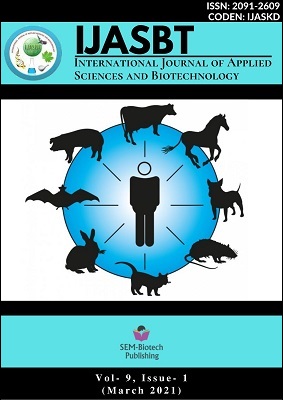Heterobeltiosis and Economic Heterosis for Grain Yield Related Traits of Boro Rice (Oryza sativa L.)
DOI:
https://doi.org/10.3126/ijasbt.v9i1.34038Keywords:
Rice; hybrid; check variety; standard heterosis; grain yieldAbstract
Rice is a staple food for more than half of the world’s population and to increase the yield potential of rice would be a key factor for mitigating global demands of about 810 million tons of rice by 2025. To exploit the economic importance of heterosis, quantitative valuation was carried out in a randomized complete block design with three replications for 16 agronomic traits of 5x5 half diallel populations during boro season of 2017-2018. Diallel populations were generated by using five selected parents (P1: BRRI dhan28, P2: BRRI dhan74, P3: BINA dhan10, P4: IR59418-7B-21-3 and P5: BRRI dhan67) where, P1 was considered as standard check to estimate the economic heterosis. Analysis of variance revealed highly significant variability among the genotypes for most of the traits except grain length and length-breadth ratio. The results showed that none of the hybrid combination performed better for all the traits over the three types of heterosis. The highest relative heterosis was recorded in P3×P4 followed by P4×P5 for grain yield plant-1, filled grains panicle-1, effective tillers plant-1. Majority of the cross combinations (>60%) revealed highly significant positive heterosis for grain yield plant-1 over mid parent. Heterobeltiosis for grain yield plant-1 was observed significant for 50% cross combinations and could be utilized in hybrid breeding. Whereas, more than 70% crosses exhibited undesirable negative standard heterosis for grain yield plant-1. Only two cross combinations (P3×P5 and P3×P4) among ten revealed significant positive economic heterosis for grain yield plant-1 and those could be exploited in rice breeding.
Int. J. Appl. Sci. Biotechnol. Vol 9(1): 45-53




